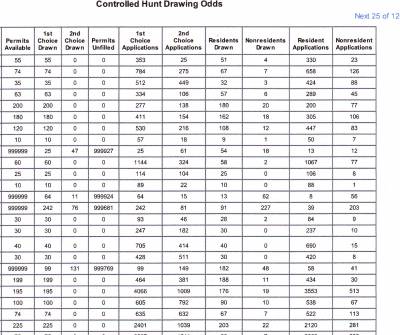
The draw odds for quality tags have worsened significantly with the rise of the information age. I did a comparison of four of Idaho’s mule draw hunts, two high-quality units and two quality units. I looked at the total licenses, applications, and draw odds percentage in 1999 vs. 2012. It’s a sad story to say the least:
In 1999, there were 400 tags available, 3,286 applicants, and 12% draw odds.
Fast forward to 2012 and 330 tags were available, 5,546 applicants applied, and 6% of hunters drew.
While odds have always been low, they are dismal now. You will see very similar trends across the West for mule deer, elk, sheep, and mountain goats. It’s for this reason that a hunter wanting to take quality animals cannot count on draw tags. Even with the various versions of point systems across the West, most will agree that they have not solved the problem of increasing demand—there’s just too many of us wanting to hunt a few units. A wise hunter now needs to view the high-quality western draws as part of his application strategy, not the focus of it.
I started playing the draws for mule deer in the early 1980’s in my home state of Idaho. By ’91, I was applying for tags across the West. At one point, I was applying in nine western states. I tracked every dollar I spent and by 2010, decided that the return for investment was falling faster than my draw odds were improving.
I also noted that in 25-plus years of applying, I’d only drawn one high quality tag. I’d scouted the unit relentlessly and did kill a great buck, but during those decades, I’d killed numerous good-to-great bucks on easy-to-obtain tags across the West in units I’d learned to hunt right. It was clear that my odds of killing a great deer were better in the easier-to-get units. That revelation changed everything for me.
I’m currently applying in six western states having dropped Montana, New Mexico, and Oregon due to poor value per dollar spent. If my funds were not limited by budget, I may have stayed in, but really wouldn’t expect a quality tag in my lifetime. I’m now trying to focus on the units I’ve learned over the decades where I have a chance to hunt most years, even if it means switching weapons. An often ignored key to killing great bucks (or bulls or whatever you hunt) is being persistent enough to hunt a unit a few years, even when you’re not successful.
My application strategy has become like a well-diversified investment portfolio. I have a mix of applications in high-demand units in Arizona, Utah, and Nevada, but also apply for hunts I’ll likely draw every other year in Wyoming and Colorado. Finally, I hunt Idaho’s general seasons every year. I’ll also buy landowner tags on occassion, never having paid more than a grand for one.
I spend 35-60 days per year scouting and hunting mule deer. That is my “secret” strategy if one exists, and one reason I choose to only hunt deer. If I maximize my time in units that have some good bucks—and many in every western state still do—I’ll eventually get the drop on one. It’s happened dozens of times and will happen again, Lord willin’ of course. And it sure feels good to be off that treadmill.
Question: How has your application strategy changed over the years?




















You sure had a string of bad luck drawing over the years! Anyway,I totally agree with your assessment. Mike Eastman touched on this a few years back in one if his books.
Ya, I can’t say I’ve had good luck in the draws, but considering I was applying for hunts that were 5% or less all those years, not surprising.
While some seem to have the luck of the Irish, others draw trophy tags every other year. I have one buddy that didn’t draw a trophy elk tag this year in AZ for the first time in 5 years. Go figure.
Comments are closed.